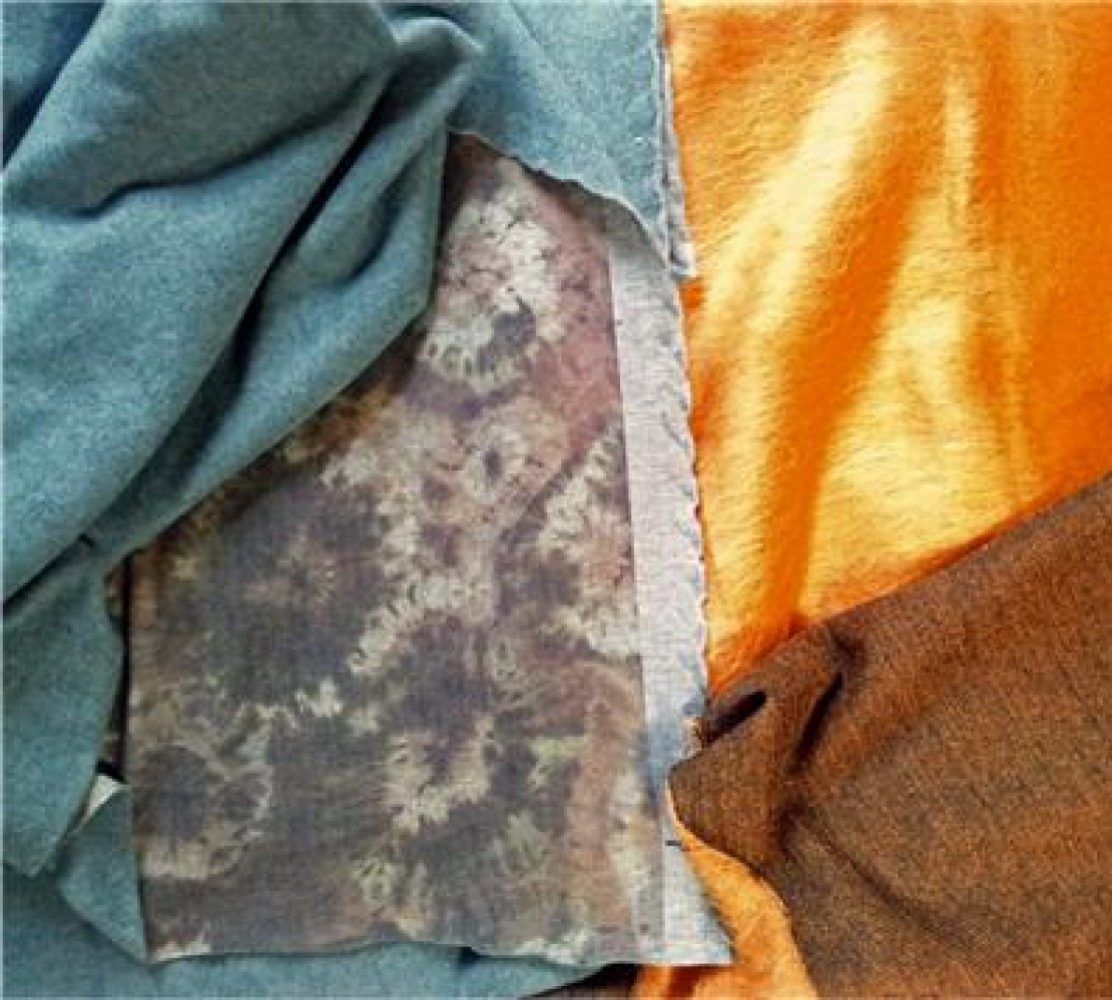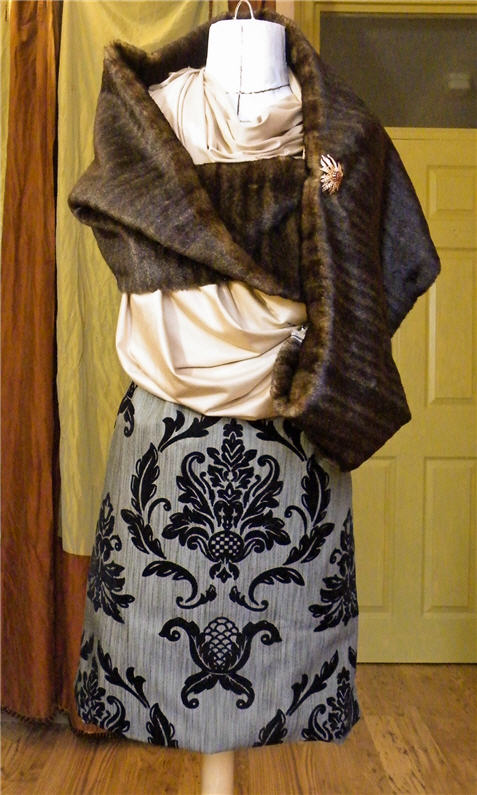First one for me, but obviously not for the internet. Skip if you’re already yawning! 😉 This one is the first of my self-drafted “straight” skirt planned for the Year of the Skirts.
Style Shots & Mug Shots
The Inspiration & Design
I normally don’t go for lace. They’re usually too dainty, or too mother of the bride conservative, or too boudoir for me.
But I loved the styling for Burdastyle 2013-03-109 Lace Skirt.

It’s so Spring like and “airy”. I know, it’s coming up to Fall. But I’m usually a season or a few years behind.
I was originally going to use this Burda pattern. But since I’m sorting out basic skirt blocks for myself, I thought I might as well test the one closest to this Burda skirt. Then I won’t have to test and alter two lots of patterns.
The Pattern
Block Used: Straight Skirt Block
This is the one derived from a combination of Kenneth King moulage and straight skirt instruction that I blogged about here.
Design Changes Made
- Moved the darts slightly to work with the lace’s regular repeat pattern. The darts are still within my acceptable range.
- Moved the side seam slightly and widen at the hem slightly, again to work with the lace’s pattern.
- For the lace layer, joined up one side seam at the hem just above the scallop to minimize piecing required.
- Went for the above-knee length. I originally planned a longer length. But after trying out on Q, I decided the shorter length looks more modern when paired with my new I’m-A-Dress-Form top. As I had already cut the lace with scalloped hem, I had to shorten from the waist.
In retrospect maybe I should have widen the hemline a bit more. Mine is not as wide as the Burda pattern at the hem. I was worried that with a straight hem rather than a curved hem (to make use of the straight scallop edge), a wider hem would dip at the side seams. But the result of my narrower hem is that my skirt doesn’t look as airy as the Burda photo.
Fabric & Notions Used
- Cotton Lace from NY Elegant Fabrics, NYC. I’m not sure what type of lace this is. It’s a bit like guipure lace, but has a simpler repeat pattern and seems more light weight than a lot of guipure lace.
- Silk Georgette from Borovick Fabrics, London.
- Silk Charmeuse (?) from Cloth House, London. I’m not sure if this is charmeuse. It feels like one. But no one in London seems to know what charmeuse is much less sell it! Scratch that. No one in the UK seems to! What’s with that?
- 23cm Lightweight invisible zipper from McCulloch & Wallis, London.
- Waist facing: petersham from McCulloch & Wallis, London; skirt eye & hook
- Sewing Helpers: Spray starch; Fray Check
Construction Notes
Well the making this skirt was hell of a needless palava. I was hell-bent on making the skirt “airy (fairy)”. But I think my pattern and fabric combination slayed my effort. The result was a bit mother of bride-y to be honest and I could have arrive at this result with a lot less hassle.
- Palava #1: To Underline or to Line. Almost all of the guipure lace skirt articles I found suggested underlining and even quilting the lace to the underlining with rows of loose hand tacking. That did not appeal to me. The examples all look too structured rather than “airy”. So after much agonizing I decided to treat the underlayers like linings, except the “wrong sides” – ie the side with visible darts and seam allowances – are inside / next to the body. The layers are joined at the waist but allowed to roam freely and independently at the hem. The two underlayers are also joined at the invisible side zipper.
In retrospect I needn’t have bothered. The skirt pattern wasn’t wide enough for the underlayers to roam freely. The cotton lace didn’t help by shrinking on contact with water it seems, making the fit even more snug. So my attempt at separate closure for the lace layer with a row of eyes and hook also failed miserably with gap-ahoy. In the end I had to hand tack the lace to the zipper edge and seal off raw cut on the lace with Fray Check. - Palava #1.1: Lace Seaming.
Because of my decision to treat the lace layer separately I suffered massive amount of hand sewing. I thought I’d try applique seaming that’s sometimes suggested for guipure lace. But the tiny overlapped edges looked bumpy. I was also afraid the machines will choke on the uneven bumps. So I ended up trimming away most of the seam allowances and then try to butt connect the cut edges by hand mimicking the lace design with tread bars and rather random overcasting stitches. As you can imagine it took ages for 4 darts and 2 side seams.
- Palava #2: Underlayer fabric choices. The reason I chose Georgette on top of Charmeuse was to soften the transition from see-through lace to opaque lining, again for a more “airy (fairy)” effect. But it didn’t really work: the transition still looked quite abrupt when I hem the two underlayers different lengths. So both ended up about the same length at the top of the scallop edging. I’ve since been studying photos of some Dolce & Gabbana lace skirts & dresses I liked to see what I did wrong. But on closer inspection a lot of them do seem to show the legs, which even when paired with granny shorts seems sadly a bit impractical for real life. I love the look, but I don’t love the hassle & snarky remarks I might get wearing that sort of outfits :.( Maybe I should have gone for flesh colored China Silk instead of Charmeuse. That might have been a better compromise to preserve modesty without an abrupt transition from lace to opaque.
- NOT A Palava: Taming the slippery underlayer beasts. For the Georgette & Charmeuse, I resorted to tons & tons of spray starch. Yeah, naughty me. But despite what the experts advice about silk (dry clean only), I plan to hand wash these. I have little space in my closet for Divas, and tailored garments have already reserved that title. So no fiddly tissue papers for me. The spray starch made these Diva fabrics much easier to handle. They still wanted to shift and slip, but at least not at a mere sneeze. It also helped to control fraying a little bit. And made it a bit easier to mark these fabrics with chalk. (I used Clover Chaco Liner. It’s the easiest of what I have that doesn’t leave a permanent mark. But I’m still on the hunt for even better marking tool / method. If you have a trick for marking slippery lightweight fabrics please do share!)
- And the Rest:
- The underlayer were french seamed by machine, and narrow hemmed by hand.
- For closure I resort to my favorite – an lightweight invisible zipper.
Mercury Handmade Fashion’s recent blog tutorial on invisible zipper in a french seam came in really handy. I had two separate layers of french seams to deal with. So it was slow going with a fair bit of hand basting. And for waist facing I resorted to petersham + skirt eye & hook like with my other recent skirts.
- And I finally took the plunge and tried out my hem marker. The white chalk powder worked surprisingly well on these ivory Georgette & Charmeuse. But to be on the safe side I thread-traced as soon as marked…using red threads. Yeah, me bad. But my aging eyes thanked me for it. But wait, what’s this, the Georgette layer still ends up with a crooked hem peaking out from under the lace shell! WTF!?!? I swear it was level when I marked. I’m hoping it’s my naughty ironing of the Georgette layer (yeah, me bad again) that maybe stretched that bit out. Hopefully a wash will relax the fabric and return it to the proper even length again. Worst case I’ll re-hem that bit.
The Verdict
The skirt is definitely wearable. But it sure was way too much effort for what it is. It’s nothing special design-wise — more of a team player than a superstar. Nor is it spectacularly flattering. I definitely could have simplify the process rather than let the lace bullied me into so much hand-sewing.
After I made this I checked out the fancy dress department at a local department store to gauge what seaming might work in the future. I think for a fitted look, the underlining approach is the way to go – ie handle the lace and an underlayer as one so the SA are all hidden by the underlayer. For a looser fitting look, I’d go with some sort of overlocked seam so that the SA sticks out from the seam and isn’t so visible from the outside (compared with being pressed to one side of the seam).


















































































